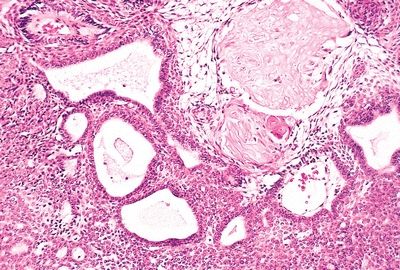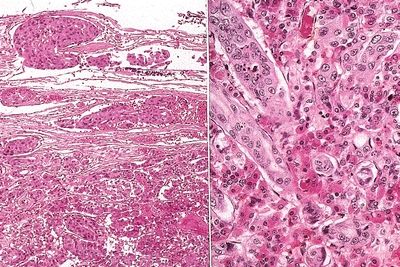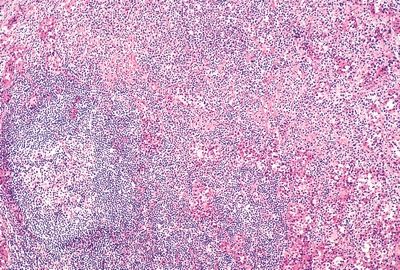QUESTION 12.1
A. Acromegaly/gigantism
B. Cushing syndrome
C. Hyperprolactinemia
D. Panhypopituitarism
E. Visual field deficits
2. A 23-year-old female undergoes transsphenoidal resection of a prolactinoma after receiving prolonged treatment with bromocriptine. Which of the following are morphologic effects of bromocriptine on the pituitary tumor?
A. Apoplexy
B. Chronic inflammation
C. Increase in cellular atypia
D. Necrosis of pituitary parenchyma
E. Shrinkage and fibrosis
3. An intracranial tumor characteristic of childhood is shown in this photomicrograph. This tumor is most likely to arise in which of the following regions?

QUESTION 12.3
A. Cribriform lamina of ethmoid
B. Petrous portion of temporal bone
C. Posterior fossa
D. Suprasellar region
E. Temporal lobe
4. A 9-year-old girl is diagnosed with central diabetes insipidus. An MRI of the head reveals a nodular lesion in the suprasellar region. This is biopsied. The biopsy reveals the changes shown in this photomicrograph. The abnormal cells in the epithelioid clusters are immunoreactive for CD1a and S100. Which of the following is the most likely diagnosis?

QUESTION 12.4
A. Granular cell tumor
B. Langerhans cell histiocytosis
C. Lymphocytic hypophysitis
D. Mycobacterial infection
E. Sarcoidosis
5. Three months after an uncomplicated delivery, a 35-year-old woman presents with signs and symptoms of pituitary insufficiency. MRI reveals a pituitary mass, which is biopsied. The biopsy findings are shown in this photomicrograph. Which of the following is the most likely diagnosis?

QUESTION 12.5
Stay updated, free articles. Join our Telegram channel

Full access? Get Clinical Tree


